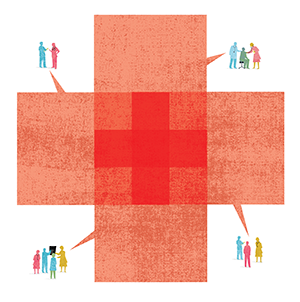In the alphabet of educational strategies and associations, the George Washington University (GW) School of Medicine and Health Sciences (SMHS) is adopting what is quickly becoming vital: IPE, or interprofessional education.
“IPE is critical,” says Matthew Mintz, M.D. ’94, RESD ’97, FACP, assistant dean for preclinical education and associate professor of medicine at SMHS, “because our evolving health care system will rely on interprofessional health care teams, which will manage the health of groups or patients.”

The idea behind interprofessional education is that communication between medical workers — physicians, specialists, nurses, physician assistants (PA), and physical therapists (PT), for example — improves the quality of care delivered, increases patient satisfaction, and contains costs, which is at the heart of health care reform and improvement.
With that shift to a patient-centered, team-based approach to health care in mind, Richard J. Simons, M.D., senior associate dean for M.D. programs at SMHS, believes SMHS is uniquely positioned to shape its medical education with the IPE movement.
“I think that we should be a leader in this area,” Simons says. “We have so many different kinds of health profession students here at GW, we have a real opportunity to set the standard nationally for IPE best practices.”
On an accreditation level, the Liaison Committee on Medical Education, as well as accrediting bodies for other health care fields such as the Commission on Accreditation in Physical Therapy Education, has added interprofessional activity as a standard for evaluation. Despite it being a requirement, however, Simons says that SMHS programs would incorporate interprofessional activity anyway.
“It’s a requirement from our accrediting bodies,” Simons says, “but it’s the right thing to do regardless of that because it’s so important to provide patient-centered care.”
For Howard Straker, PA-C, M.P.H., assistant professor of physician assistant studies and assistant professor of prevention and community health at SMHS, the accreditation is becoming “more and more standardized.”
“Health care has gotten more complex,” Straker says. “There is a need for interprofessional teamwork.”
With that shift to a patient-centered, team-based approach to health care in mind, Simons believes SMHS is uniquely positioned to shape its medical education with the IPE movement.
Teamwork is integral to patient care not just for quality purposes, Straker explains, but also for patient safety. When physicians maintain contact with nurses and pharmacists, he says, medical errors, such as a wrong dosage or medication, are far less likely. In order to keep those channels open, however, there must be an understanding across fields. That shared decision-making and communication is where GW’s extensive resources come in.
“The beauty with George Washington is that everybody is right here on the campus,” Simons says.
“Everybody,” he explains, refers to all students pursuing health-related careers, from medicine to speech pathology. Bringing the students and schools together is no small task, given the logistical challenges of conflicting schedules. “You have to find ways to overcome those logistical challenges to get this done,” Simons adds.
Recently, more than 300 first-year medical and PA students, second-year PT students, and speech-language pathology and registered nursing students gathered for two workshops, one in fall 2014, the other the following spring. The goal, says Jennifer Halvaksz, DPT, academic director of the Johns Hopkins/GW Orthopedic Residency Program and assistant clinical professor of physical therapy and health care sciences at SMHS, was “getting students to think about other professionals and how this team notion could synthesize and synergize into better overall health care.”
At the fall workshop, students were introduced to interprofessional education through role-playing. Prior to the class, each student was assigned to a health profession other than his or her own; each then had to explore the “footwork,” as Straker says, or the scope of practice, training, and schooling of the area. After meeting with those in the assigned profession, students broke into groups and analyzed case studies from the perspective of their assumed role.
“The students seemed to enjoy meeting each other,” Straker says, “and getting to know the roles of other professions.”
At the spring workshop, focus tightened on clarity and respect in interprofessional communication. The students, Straker says, were given a case to study prior to the workshop. Faculty, likewise from a range of health professions, played the role of patients with multiple sclerosis (MS), for small student groups. The students, who had varying degrees of knowledge of MS, were tasked with gathering patient histories and discussing plans of action. They also incorporated the SBAR strategy.
“[SBAR] stands for ‘situation,’ ‘background,’ ‘assessment,’ and ‘recommendations’ for dealing with a clinical scenario,” Simons says. “It’s analogous to what happens in the airline industry, using these standardized checklists.” The workshop concluded with peer evaluations, a key tool for participants to assess their performances and communication skills with others.
Judging by anecdotal evidence, both Straker and Halvaksz say the workshops were a success, both for imparting information and allowing students to strengthen their interprofessional competency. Plans are underway to continue IPE and expand the workshops, with some changes.
“We will likely modify these sessions based on feedback from faculty and students,” Mintz says. “For example, the spring session presented a case that was role-played by faculty. Hopefully, for next year, we will utilize standardized patients to portray the case. In addition, we will continue to look for IPE opportunities at our shared clinical sites when our students are on their clinical assignments.”
Related Content:
- Link to Revised M.D. Curriculum



